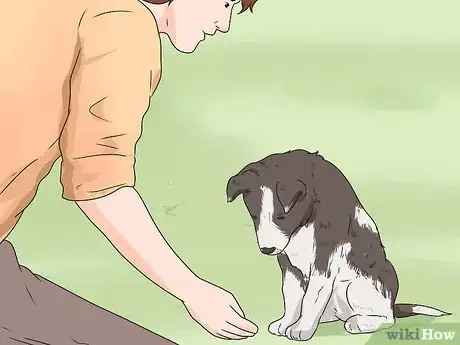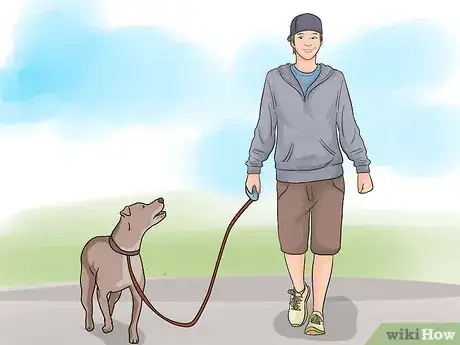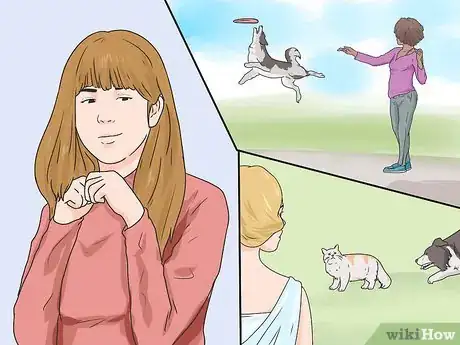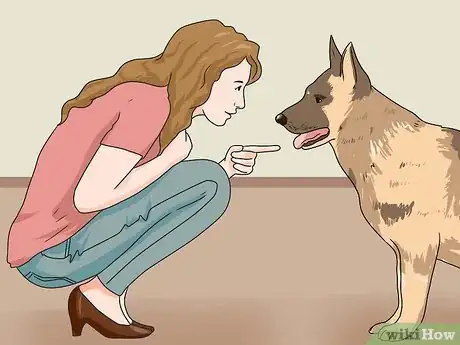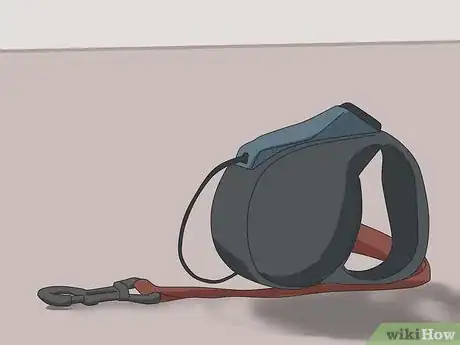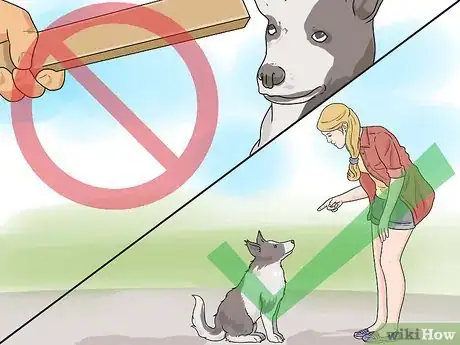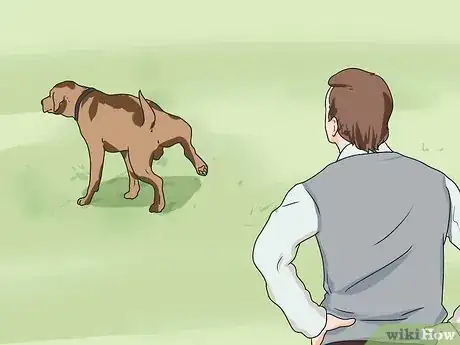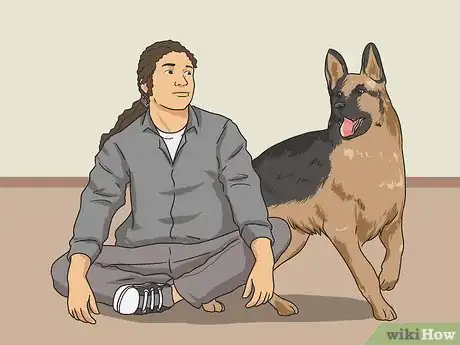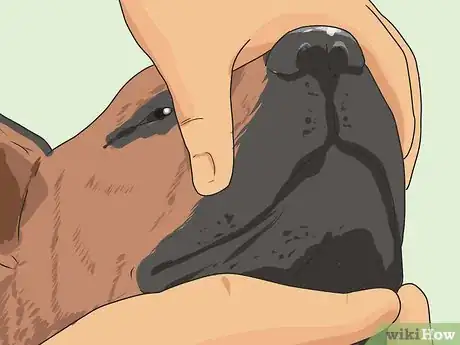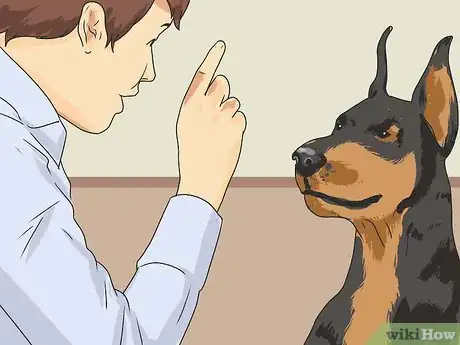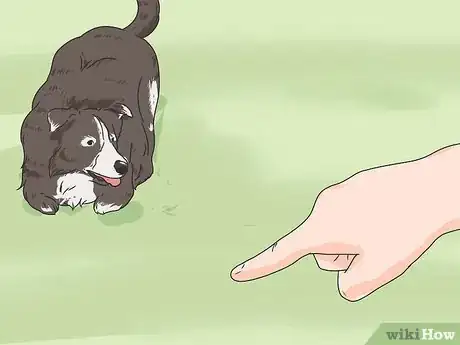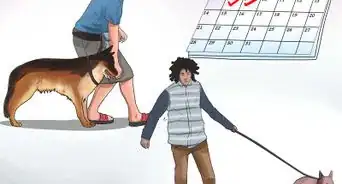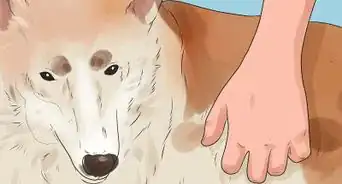This article was co-authored by Emily Fleisher, CTBC. Emily Fleisher is a Certified Dog Trainer and Behavior Consultant (CTBC) and the Founder of Mindful Paw, a dog training business based in San Francisco, California. She is certified in canine CPR, first aid, and dog training from the Dog Training Internship Academy. She also has a Certificate of Excellence through Dr. Susan Friedman's "Living and Learning with Animals" program. She completed an internship at the San Francisco SPCA (a Society for the Prevention of Cruelty to Animals) and continues her education through the Fenzi Dog Sports Academy and Jean Donaldson's Academy for Dog Trainers. She has a BA in Public Health from the University of Florida.
This article has been viewed 46,077 times.
In order to train any dog, you must establish trust and obedience through positive reinforcements and calm assertions of discipline. When training a timid dog, you face a whole new set of challenges because many of the things that we see as being potentially helpful can actually be harmful. The first step in this long process is to build trust.
Steps
Building Trust
-
1Earn your dog's trust. Your dog will not obey you if he doesn't trust you. To instill trust, you must show the dog that when something scary happens, it is going to be okay. Be patient. Give your dog space, and your dog will come on its own. This is especially important if you’re introducing your dog to a new environment where they may be scared.
-
2Establish yourself as the alpha. Never confuse empathy with allowing your dog to be dominant. Your dog doesn't determine what happens. You do. You must establish yourself as the alpha, which that means that your calmness and assertiveness are the keys to unlocking your dog's happier, more obedient self. When something scary happens, you need to project a calm and assertive energy.[1]
- Don't reward timidness or fear. Dogs can sense your energy. If your dog becomes afraid or scared, and you instantly begin petting him and making a fuss over him, you are now rewarding that undesirable behavior. Too much compassion can harm your dog's development even more.
Advertisement -
3Build confidence, not dominance. Your dog needs to be confident while still realizing that you are the alpha in this relationship. Remember: confidence is not dominance. To build this kind of confidence, you must introduce the dog to new situations where he can observe and learn from other confident dogs and people without feeling threatened. This can take the form of obedience training, obstacle courses, or breed-specific skills training.
- Start off small and ensure that your dog achieves small successes. Each of these small successes builds self-confidence, helping manifest a more confident and happy dog.
- To do this, the dog has to experience many new situations every day. Even just walking down a busy street can help expose your dog to new activities that will help desensitize him to the world.
- Remain calm and assertive throughout the process. If your dog senses that you are anxious or reacting negatively to his fear, it will only perpetuate his fear. Never deal with a timid dog when you are feeling short-tempered or distracted. Any dog, especially one that has such low self-esteem, is extremely sensitive to what you do.[2]
-
4Give your dog treats. Hold a few dog treats in your hand and give him a few treats when he comes near you. This will teach him that you don't want to hurt him and that being with his owners is rewarding. Praying your dog by saying "Good boy!" can eventually take over for treats. Your dog will learn to admire you, and showing that you appreciate him goes a long way.
- Look for treats that are healthy, made without the use of any preservatives. Make sure that they're grain-free, and that they contain meat.[3]
- Take treats with you when you take your dog out with you. This way, you can train and reward them on the go.
-
5Gradually introduce your dog to more and more experiences. Once your dog has started building a little bit of self-confidence by mastering new stimuli, you must ensure that he doesn't plateau or grow bored. New experiences are key. Whether there is a fair in town, or you take your dog to a new dog park, mastering unfamiliar stimuli is potentially the most important way for your dog to make progress. Over time, each success will build your dog's confidence.
- Be patient. Eventually, this integration with the world can lead to a significantly less timid dog, one who can appreciate his surroundings without fear clouding his behavior.[4]
-
6Devote yourself to helping your dog. Your dog deserves the best version of you and you cannot be the best version of yourself if you are not prepared to have a calm, assertive mindset every time you work with your dog. Never give up on your dog. There is always hope. You may even find that as you help your dog achieve a calmer and happier state of mind, you ease your own mind.
- It takes time to get to know your dog and their distinct personality. If you’ve only been around this dog a few days, don’t rush things. You and your dog will bond and get to know one another soon enough.
Exercising Discipline
-
1Get a leash. A leash is essential since an unleashed shy dog will evade you as soon as he gets the chance. Getting a leash clipped onto a shy dog is a feat in itself. You may have to climb under the table or wherever the shy dog is hiding and reach gently to hook the leash without looking the dog in the eye. Pet the dog under the chin and speak brightly, without making eye contact, once you've clipped the leash.
- Get up and walk confidently away, saying "come!" happily while holding the leash. Do not look at him, but look forward. Pull your timid dog gently along behind you. Try coaxing him out with the promise of a treat.
- Don't even try working on any commands until your shy dog will follow you around without dragging on the leash. Once he's following you reliably, reach to pet him without making eye contact, and reward with plenty of treats.
-
2Discipline with words, not with violence. This is especially important with timid dogs. Never hit or hurt an animal to indicate bad behavior. Instead, use sharp sounds like "Hey!" or "No." Reinforce good behavior as much possible. Praise your dog with a relaxed, soothing tone, much like the voice you'd use to calm a crying baby. Make sure to have plenty of training treats on hand, and to give him lots of encouragement when he does the right thing.[5]
-
3Train your dog to pee outside. This is best taught right away. Once your dog is comfortable with you being near him and touching him, you can begin the training process. If your dog still pees in the house, yelling at him might affect his trust for you. Instead of yelling, watch your dog all the time so that you can catch him peeing in the house. As soon as he starts peeing, pick him up and bring him outside so he can continue to do his business there. Give him a treat every time that he pees outside, or continues to pee outside.[6]
- Give your dog plenty of time outside, especially if he is a larger dog. Give him time to pick his own spot to relieve himself.
- If you have a much larger dog and you can't pick him up, take the dog out more often. If you catch the dog peeing in the house, give a firm No, but do not yell. Lead the dog outside and reward the dog for continuing outside.
-
4Use another dog as an example. If you already own a confident dog, this can smooth the training process. A shy dog will mimic a confident dog. Take them both out into an enclosed yard or living room, and bring lots of treats. Sit on the ground, and call your confident dog over by saying "come." Reward with a treat.
- You may need to bring your timid dog out on a leash. You may need to gently drag him. The important thing is you establish a comfortable, low-pressure dynamic. Let your timid dog get used to sharing a space with both you and the more confident dog.
- If your shy dog even takes a few steps toward you, reward him by throwing a treat toward him. Gradually throw the treats closer and closer to you, until the dog will come all the way to you!
- Sitting on the ground makes you less scary, and the dog will be more likely to want to approach you. With a very shy dog, you may have to lay flat on the ground!
-
5Train your dog not to bite. Remember that you should never get angry or violent with your dog. Your timid dog will lose his trust for you if you hit him even once. If you catch him biting your clothes, hands, toes, or anything you're holding, grab his snout and rebuke him with a firm No."
- Don't hold on for too long–just enough that he gets the message. Don't grab too tight, and do not hurt the dog. You don't want him to feel threatened, you only want him to stop biting you.
- Remember that biting is natural for dogs. If your dog is biting you, it doesn't mean that he doesn't like you. Do not be offended. Try to understand where your dog is coming from.
-
6Be stern, but patient. Speak directly to your dog, in a commanding voice:[7] "Max, sit." If he sits, reward him with a treat. If he does not sit, repeat the command firmly without elevating your voice or losing your composure until he sits.
- When you are just beginning to train, you may need to show your dog that you want him to sit. Give the command, then push on his rear just enough that he relaxes and sits. Reward and repeat.
-
7Teach your dog more complex commands. As your dog becomes more comfortable interacting with you, your household, and the outside world, you can begin to train the dog to sit, come, stay, roll over, and beyond. Base your training on a reward system. Keep your dog thinking that what he is doing is good and that you are pleased with his behavior. It's much easier to train your dog to behave well than to punish for behaving poorly. Dogs don't respond to punishment, but they do respond to treats!
- Consider bringing your dog to obedience school. A structured, rewarding learning environment can help some dogs progress much more quickly.
- Consider visiting obedience-training tutorial websites. Look for YouTube tutorials. Some experienced dog trainers have posted step-by-step videos or instructions on how to teach your dog various tricks.
Community Q&A
-
QuestionCan a timid, loving chihuahua be trained not to pee when greeting people?
 Community AnswerMany dogs do the excited pee, some truly cannot control it. One thing you can try is to have your guests ignore them at first, give them a few minutes to calm down before interacting, and then greeting the dog in a low/normal tone of voice instead of using a "baby" voice. If this doesn't work, you may just have to get used to it.
Community AnswerMany dogs do the excited pee, some truly cannot control it. One thing you can try is to have your guests ignore them at first, give them a few minutes to calm down before interacting, and then greeting the dog in a low/normal tone of voice instead of using a "baby" voice. If this doesn't work, you may just have to get used to it.
Warnings
- Never hit your dog. Violence won't aid the training process, and it is not necessary. Many consider it abuse.⧼thumbs_response⧽
References
- ↑ https://www.forpaws.org/articles/alpha.htm
- ↑ https://www.whole-dog-journal.com/behavior/help-your-shy-dog-gain-confidence/
- ↑ https://www.whole-dog-journal.com/food/how-to-identify-and-pick-top-quality-dog-treats/
- ↑ https://www.whole-dog-journal.com/behavior/help-your-shy-dog-gain-confidence/
- ↑ https://petcube.com/blog/dog-training
- ↑ https://www.americanhumane.org/fact-sheet/housetraining-puppies-dogs/
- ↑ https://vcahospitals.com/know-your-pet/humancanine-communication-tone-vs-volume
About This Article
Before you can train a timid dog, you’ll need to work on building up its trust and confidence. To do this, be patient and give your dog plenty of time and space to get used to you. As your dog is warming up to you, establish your authority by being calm and assertive with it. Avoid rewarding timid behaviors by making a fuss whenever it gets scared. To help build your dog’s confidence, introduce it to new experiences slowly and reward it whenever it deals with a new situation successfully. For example, you might give your dog a treat and some praise when it gets brave enough to approach you on its own. Once your dog masters a skill or gets used to an experience, introduce it to something new. For more tips, including how to discipline your timid dog appropriately, read on!
